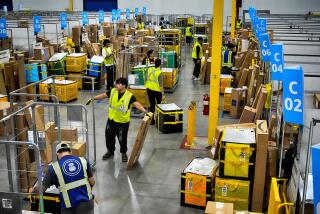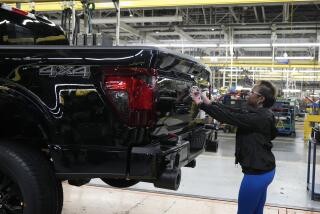Productivity falls for 1st time in year
WASHINGTON — The productivity of U.S. nonfarm businesses dropped in the second quarter at a 0.9 percent annual rate, the first decline after five quarters of strong growth, the Labor Department reported Tuesday.
The reversal suggests that employers looking to increase output may need to hire more workers, a boon for the sluggish job market.
In the second quarter, hours worked increased at a 3.6 percent annualized rate, the fastest since the first quarter of 2006, the government estimated.
But output growth didn’t keep up, climbing at a 2.6 percent rate in the second quarter, down from a 5.0 percent rate in the first quarter.
The 0.9 percent fall in productivity for the second quarter was worse than the 0.4 percent decline forecast by economists surveyed by MarketWatch.
U.S. productivity in the first quarter was revised up to a 3.9 percent rate from the prior estimate of a 2.8 percent gain.
Productivity, defined as real output divided by hours worked, is one of the most important — but elusive — economic data points. Productivity gains, if the benefits are shared, can hold the key to better living standards, higher wages, increased profits and low inflation.
In practice, though, productivity is extremely difficult to measure: The government’s numbers are subject to huge volatility on a quarter-by-quarter basis.
Companies continued to cut costs and work employees harder. As a result, some economists believe that companies will need to add workers to increase output.
“The labor force is starting to get stretched,” said Gary Bigg, economist at Bank of America/Merrill Lynch.
“One could argue this report is positive for employment growth going forward,” he added.
Other analysts are skeptical, believing that sluggish final demand will keep firms from adding workers in droves.
Over the past four quarters, productivity moderated to a 3.9 percent gain, down from a 6.3 percent annual rate in the first quarter, the fastest in 48 years.
Unit labor costs rebounded at a 0.2 percent rate in the second quarter after dropping 3.7 percent in the first quarter.
As the name implies, unit labor costs are what businesses pay for the labor needed to produce a “unit” of output, whether it’s tons of steel or words of journalism.
In the past four quarters, unit labor costs are down 2.8 percent.
Compensation per hour fell 0.7 percent in the second quarter. Real compensation per hour — that is, adjusted for inflation — was flat.
Real hourly compensation has slipped 0.7 percent in the past four quarters.
Productivity in the manufacturing sector alone rose at a 4.5 percent annual rate, up from a revised 1.2 percent rate in the first quarter.
Robb writes for MarketWatch.com/McClatchy.
More to Read
Inside the business of entertainment
The Wide Shot brings you news, analysis and insights on everything from streaming wars to production — and what it all means for the future.
You may occasionally receive promotional content from the Los Angeles Times.










